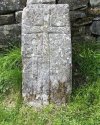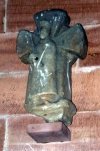ST. CUTHBERT’S CHURCH, NETHER DENTON, CUMBRIA, UNITED KINGDOM.
|
|
|
|
ST. CUTHBERT’S CHURCH, NETHER DENTON, CUMBRIA, UNITED KINGDOM.
|
|
|
|
When you have picked up these notes, (of course, visitors to the Website version need to imagine that they are actually standing outside the church at Nether Denton), it is suggested that you go out of the Church and walk back down the path to the entrance gate in the boundary wall. These notes of guidance follow logically from there. You will find a map of the site with the outline of the Roman Fort superimposed on it, inside the church on the southwest wall.
THE SITE: St. Cuthbert’s stands on the site of a Roman Stanegate fort of pre-Hadrianic date. It’s Roman name is unknown. It has never been systematically excavated, and not a great deal is known about the fort. A map of the site with the outline of the Roman fort superimposed upon it appears inside the church on the SW wall at the back.
Right. Off you go!
 AN OLD
GRAVESTONE stands close up against the boundary wall on the left just
above the churchyard lamp post. On it are carved a cross and a sword, indicating that the
person it commemorates was both a Christian and a Soldier. It’s date may be Medieval.
AN OLD
GRAVESTONE stands close up against the boundary wall on the left just
above the churchyard lamp post. On it are carved a cross and a sword, indicating that the
person it commemorates was both a Christian and a Soldier. It’s date may be Medieval.
THE ROMAN ALTAR, as it is known, will be seen close to the Church wall on the West of the entrance porch, (which is on the South side, and is the main entrance to the church). Whilst is it called a Roman Altar, there is some doubt as to its actual intended use. The hole in the top is much deeper than the shallow depression found in Altars intended for the burning of incense. It more resembles a Font, having a drain in the bottom, but there again, since in the old days babies were commonly immersed,, it hardly seems big enough to hold a baby. One other suggestion is that it was an Ossuary, intended to house the bones or ashes of a deceased person. Similar "Altars" have been reported from Roman sites in France, and these are identified as ossuaries. The experts must decide this one!
Before you enter the church, note on your right, opposite the church door, THE GRAVE OF Dr. F. G. SIMPSON, the noted Archaeologist of the Roman Wall, who died in 1955.
And so into THE CHURCH. The church you have entered is not the original building. This church was built in 1870, (At a cost of £1652). The previous building, of which no illustration exists, was described in 1703 as "In a very ill state, the South wall ready to fall, the Chancel worse, and the Parsonage House in as woeful a condition". It was evidently ready for a rebuild.
But a church stood on this site before Lanercost Priory was built. Old records show that there was a building here before 1157 AD.
THE BELL. In 1689 the Churchwardens wrote, "We have a very bad bell..." In 1719 they wrote, "The steeple of our parish church is not in good repair, neither have we any bell"! In 1749 a Terrier, (A church list) records, "One bel, the weight uncertain". In 1868 a new bell was presented by a local man. It was made by J Taylor & Sons of Loughborough. Repairs to the bell and its mechanism have now been completed. The scaffolding is to remain in place until the work on the windows has been done.
 THE NETHER DENTON CROSS. This
has now been fixed to the West wall
inside the church.
This was discovered in 1941 during some clearance work
in the churchyard, and brought indoors for safety. It is unusual, and has been dated not
earlier than the twelfth century.
THE NETHER DENTON CROSS. This
has now been fixed to the West wall
inside the church.
This was discovered in 1941 during some clearance work
in the churchyard, and brought indoors for safety. It is unusual, and has been dated not
earlier than the twelfth century.
AN OLD CANDLEHOLDER stands in the Northeast window near the pulpit. It was discovered recently in the church, and gives some idea of the level of illumination offered to worshippers in the old days. It is believed to have come from the old church.
THE ORGAN was installed in1909, and is in need of renovation. A modern electronic instrument is at present in use.
THE STAINED GLASS WINDOWS are the work of Charles Alexander Gibbs, (1825-77). Depicted in the East Window are the Adoration of the Shepherds, The Crucifixion, and the Baptism of Jesus, The window is dedicated to the memory of John Waugh and his wife Margaret. The date, 1869.
Before you leave the windows, try a bit of detective work. Look at the sun and the moon which are in the East window, above the picture of our Lord on the cross. Have you noticed what is wrong with them? In St. Matthew’s gospel Ch. 27:45, we read, "Now from the sixth hour, (Midday), there was darkness over all the land until the ninth hour". (3 pm).
St. Luke 23:45 give the reason: "And the sun was darkened...". C.A. Gibbs’ portrayal of a Lunar Eclipse is incorrect.
The window in the Southeast wall shows on the left, St. Cuthbert carrying the head of King Oswald, and on the right, Bishop Ridley, who was a local man.
The leadwork and glass of all the windows is in the process of
restoration. Work on the East window is complete, and the others are due to be completed in August 2000. A new carpet is to be laid on completion of these works, hopefully to be ready for the Harvest Festival Celebrations in the Autumn.THE BISHOP’S CHAIR in the Chancel, was donated in the early 1900s by the Waugh family.
(A more detailed description of the Church and its contents is given in the Short Guide and History booklet, available from the sales table).
It is encouraging to look back over the 840 years, (And perhaps longer), that Christians have been worshipping God on this site. They may have had to cope with the Dark Ages following the withdrawal of the Romans. They will have heard the teaching of St. Cuthbert as he passed by on his way to Lindisfarne.in the 7th. century. They will have experienced the troubles of the Anglo-Scottish wars during the 11th. & 12th. centuries, and the looting and burnings of the Border Reivers in the 15th. & 16th. Through ill times and good, God was worshipped, the people prayed and believed, and the Gospel was declared.
You are invited to quietly remember for a few moments what has gone by, and thank God with those who still worship here week by week, and look for the coming of our Lord Jesus Christ; who is "The same, yesterday, today and for ever".
This page was compiled by Dennis Adams and Fred Chipchase on behalf of Nether Denton Parochial Church Council ©1999,2000